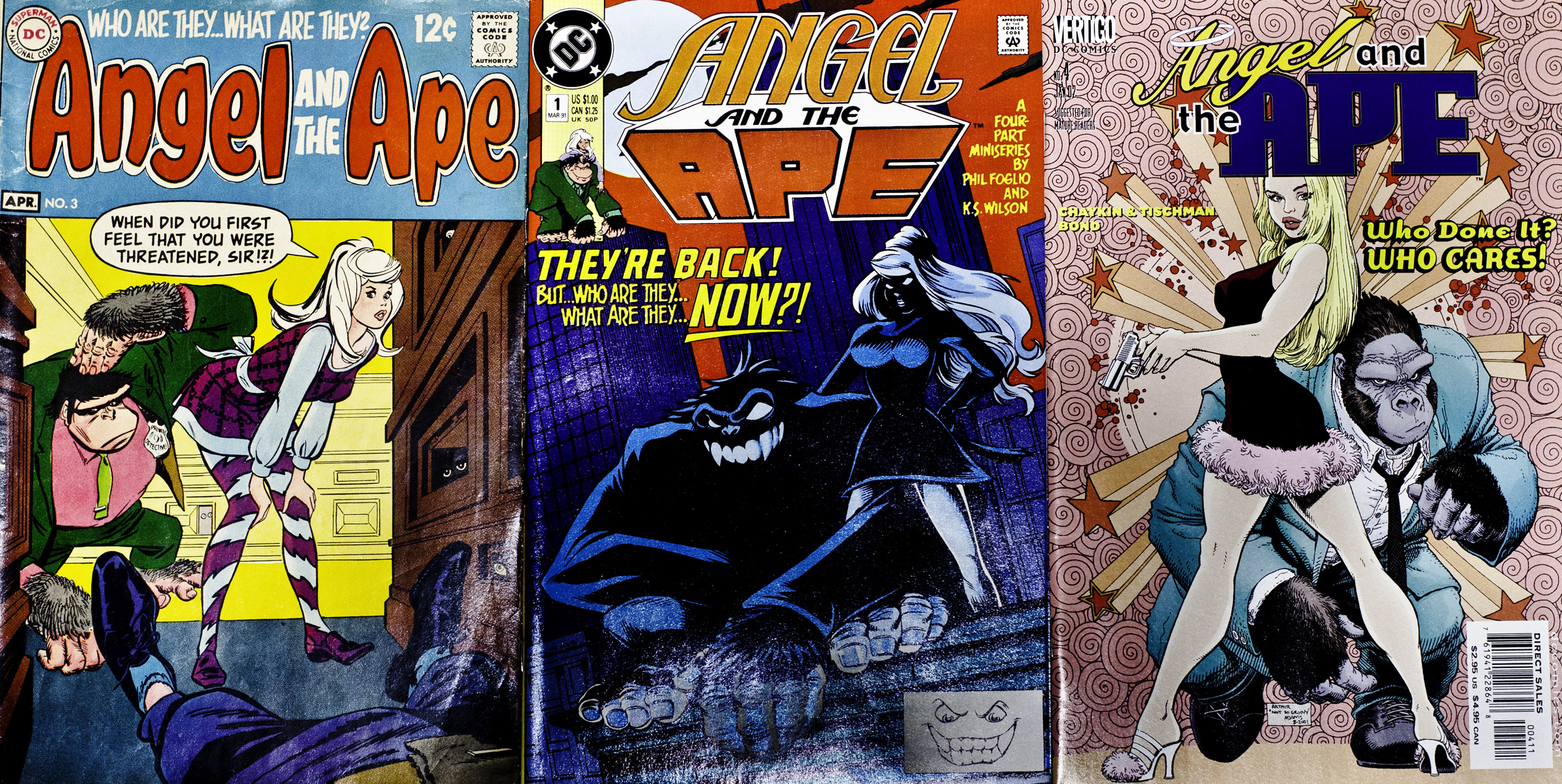
In the late 50s, DC Comics editors Irwin Donenfeld and Julius Schwartz noted that sales went up every time an one of their comics featured an ape on the cover. Predictably, what followed was a flood of simian-centric issues. By the late sixties, most every DC superhero had some form of monkey nemesis/partner/associate, and the magazine racks were filled with “LORD OF THE FLYING GORILLAS!”, “PUBLIC CHIMP NO. 1!”, “SUPERBOY GOES APE!”, and other such eye-catching stories.
So, in 1968, it was only natural that a new humor series featuring a monkey protagonist would be launched. Mad Magazine alumnus E. Nelson Bridwell wrote a try-out story in one DC’s Showcase, and a number one issue followed a couple months later. The lead characters were Angel O’Day (a lovely and ditzy private eye) and Sam Simeon (a comic book artist, Angel’s part-time investigative assistant, and full-time gorilla).
The original series was pure camp, each story involving some bizarre case involving monsters or haunted houses or absurdly stilted hippie/beatnik protagonists. Angel drifted cluelessly through case after case, Candide-like and unscathed, miraculously avoiding villains and booby traps and leering old men; Sam drew comics, spoke in gibberish (conveniently translated for the readers), and showed up in time to help save the day; everything was very “wacky” and “swinging” in the way that only forty-somethings could imagine the young people of America would identify with. There’s a beatific cluelessness to 60s DC comics, a quaint charm in their attempts at being hip. Odd characters populate these issues, laughable sterotypes of youth culture filling every page. Bob Oskner’s art is breezy and full of movement, the stories all hijinks and absurd twists, and cheery irrelevance reigns. But despite the public’s supposed hunger for anything with monkeys, only seven issues were published… And thus, our heroes faded into obscurity.
A couple of decades later, the 1990 limited series suffers from different flaws — creating a convoluted plot involving a threat to all humanity and pointlessly (but valiantly) attempting to establish the lead characters as existing in the greater universe of Superman/Batman/etc. Angel is now the sister of Bunny from The Inferior Five (another short-lived DC humor title), Flash villain Gorilla Grodd, revealed to be Sam’s grandfather, is the agressor of the piece, and there’s some strange alien Green Lanterney artifact that’s being used to bend time and turn people into gorillas… The story bogs down a bit with all of these elements shoehorned in, but it’s still a fun little read. There are a couple other deviations from the original series: Angel is now more dumb than ditzy; Sam speaks fluent english and has the ability to appear human (in the 60s stories, everyone assumed he was just a funny-looking and unusually hairy guy). Phil Foglio’s script and art are light-hearted, there’s some banana jokes, and everyone lives happily ever after. And that was it for another eleven years.
Now, on to the 2001 series, which is a whole different barrel of… Well, nevermind. It was published under the Vertigo mature readers imprint, and as such, it’s a much “edgier” take on the material. There are murders, flashes of nudity, gunplay, a midget transvestite, scenes in stripclubs and bars and doctor’s offices, profanity, and a few doses of sexual perversions thrown into the mix — for no ascertainable reason except to make sure nobody misses that it’s a comic intended for adults. The leads have also been re-remodeled: Angel is clever and adept, Sam is completely silent and possesses a rather inconvenient fear of heights. All of the mental powers and ties to DC continuity are gone, and nobody seems to care or notice that Sam is a gorilla. (I suppose it’s likely that in this context of freaks and weirdos, a well-dressed ape barely even rates a second look.) Somehow, though, there’s a good nature to the proceedings, and that comes through all the provocaton and forced weirdness. Writers Howard Chaykin and David Tischman throw in plenty of superfluous fetishes, but they keep the leads likable and innocent through it all. Philip Bond’s blocky-yet-fluid art is perfect for apes and goons and pretty girls alike. The basic whodunnit plot filled with twists and turns: stuff happens, people die, clothes are shed, the killer is revealed, and it closes with the leads walking off, arm-in-arm.
And there you have it: Angel And The Ape. Forty-odd years and three unique interpretations. Each was short-lived, none was a smashing success, yet many people (myself included) think of it fondly. After all, there is a certain appeal to the concept… a girl detective and her gorilla pal against the world.
None of the Angel And The Ape series are currently in print in collected form, but the individual issues are easily available though your local Comic Shop (or eBay).

Good times!